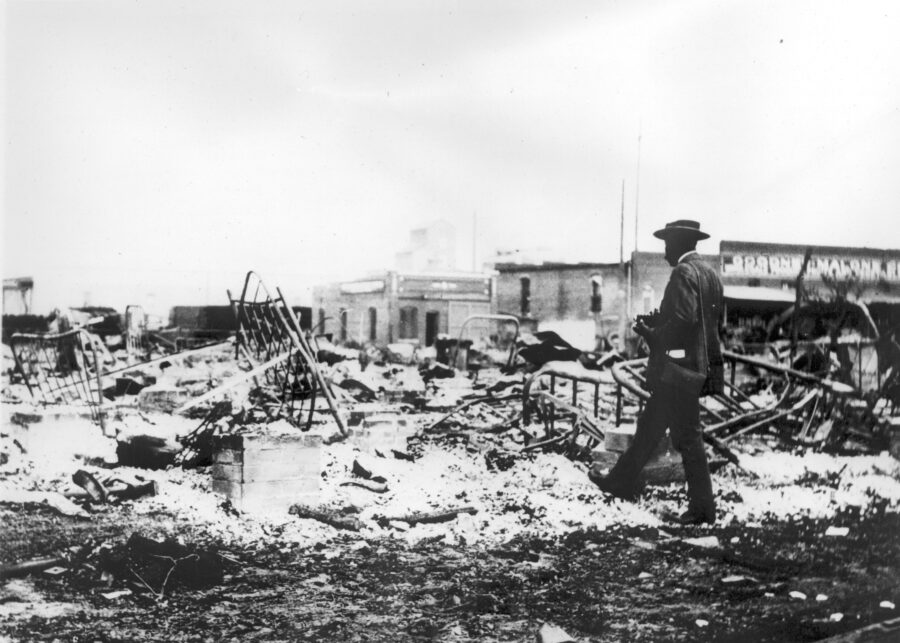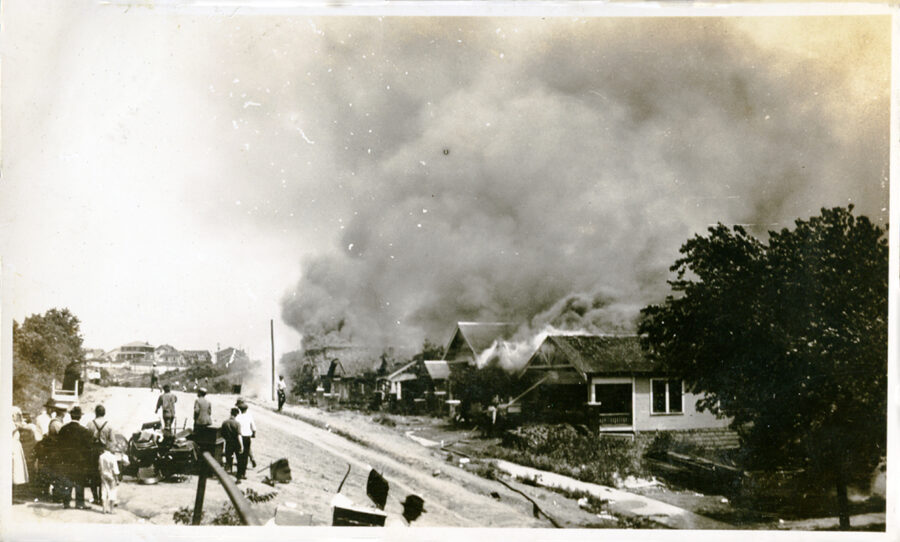
The atrocity of the Tulsa race massacre still horrifies today. Just over a century ago, Black families were dragged out of their homes, businesses were burned to the ground and gunshots rang out through the flames. A white mob, aided by local law enforcement, had desecrated what was once heralded as “Black Wall Street,” a thriving Black enclave in the Greenwood District of Oklahoma.
On May 30, 1921, rumors swirled through Tulsa’s white community that a 19-year-old Black man named Dick Rowland had assaulted white 17-year-old Sarah Page in an elevator. While it’s unknown exactly what happened between the two, the accusation was later proven false. However, Rowland was arrested that day and placed in the courthouse.
Local newspaper coverage further fueled white ire, including a story in the Tulsa Tribune with a headline that implored readers to “nab” Rowland. In the evening of May 31, a white mob arrived at the courthouse demanding the sheriff hand him over. Armed Black residents showed up to protect Rowland but were blocked by the sheriff. Later that night, a fight broke out and shots were fired, sparking the violence that would lead to a long night of terror.

The white mob that terrorized Greenwood had help from city officials, who supplied some of them with weapons. There was even a report of planes possibly dropping turpentine bombs during the massacre, according to a first-person account by an Oklahoma lawyer. Greenwood residents were terrorized — some even dragged out of their homes, their neighborhood looted and burned. By morning, the 35 city blocks that made up the Greenwood District were destroyed. Eventually, martial law was declared by the governor, and the National Guard was dispatched to put out fires and round up Black residents. Six-thousand were detained.
Historians estimate that 300 people were killed during the massacre, but about only three dozen deaths were recorded, including some who were white. Over 1,000 homes were destroyed, and churches, businesses, schools, a hospital and a library were burned, too. The Red Cross and others eventually provided aid for the nearly 10,000 people left homeless and without basic needs.
In the end, the charges against Rowland were dropped. But no one from the white mob was ever punished. Reparations for survivors of the destruction never came. Black residents were left to rebuild by themselves. Around the 1940s, Greenwood started to thrive again, but eventually “urban renewal” programs and redlining hindered the potential for generational wealth in their community.

Efforts to right the wrongs of the Tulsa massacre are still happening today. In 2001, the Race Riot Commission released a report, recommending reparations for survivors and descendents. In 2021, three remaining survivors testified to Congress about their eyewitness accounts and also called for reparations. Recently, the remains of possible victims were exhumed in an effort to sequence the DNA and match them with living descendants.
Still, many Americans didn’t know about the Tulsa massacre until recently — if they know about it all. A 2021 survey by The Oklahoman, found that 83% in a survey of state residents said they never had a full lesson in their school about the massacre. In fact, lessons about the massacre weren’t included in academic standards in Oklahoma until 2002, and teachers weren’t advised on how to cover it until 2019. While there are now online tools for teaching about the burning of Black Wall Street and it is included in some history textbooks, there is no country-wide educational standard for teaching about it.
It wasn’t until a few years ago when television series like “Watchmen” and “Lovecraft Country” depicted the events of the Tulsa massacre that it reached national consciousness. The centennial of the massacre in 2021, in which the federal government acknowledged what happened, also brought more attention to it.
There are still major gaps in what is known about the victims, and the nation has barely scratched the surface in trying to repair the damage. But with awareness rising, the racial violence in Tulsa 102 years ago will not be forgotten.


